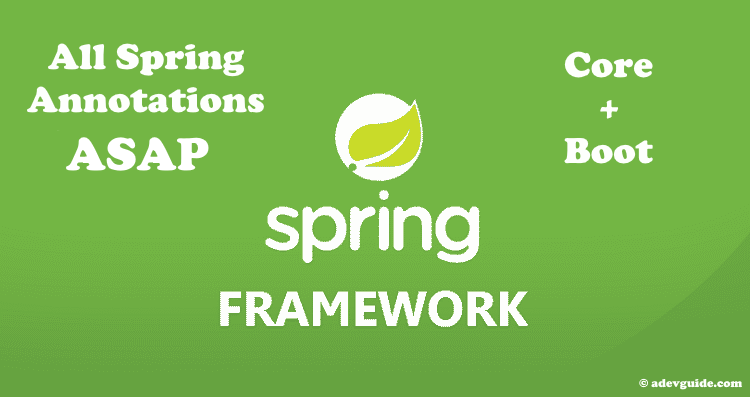

HIBERNATE ANNOTATIONS CHEAT SHEET CODE
Spring Framework started out with XML configuration and over time it has introduced many capabilities to reduce code verbose and get things done quickly. Nowadays, there are so many spring annotations that it could become overwhelming. In sum, Spring Framework provides developers with all the tools and features the need to create loosely coupled, cross-platform Java EE applications that run in any environment. It integrates with various Java EE technologies such as RMI (Remote Method Invocation), AMQP (Advanced Message Queuing Protocol), Java Web Services, and others. Spring Framework also offers built-in support for typical tasks that an application needs to perform, such as data binding, type conversion, validation, exception handling, resource and event management, internationalization, and more. This enables developers to create modular applications consisting of loosely coupled components that are ideal for microservices and distributed network applications. Spring Framework offers a dependency injection feature that lets objects define their own dependencies that the Spring container later injects into them. These features work together to provide you with a tool that allows you to set up a Spring-based application with minimal configuration and setup. The ability to create standalone applications.An opinionated approach to configuration.Java Spring Boot (Spring Boot) is a tool that makes developing a web application and microservices with Spring Framework faster and easier through three core capabilities: It uses Hibernate Query Language (HQL) as an object-oriented query language to perform database operations.Java Spring Framework (Spring Framework) is a popular, open-source, enterprise-level framework for creating standalone, production-grade applications that run on the Java Virtual Machine (JVM). It uses Java Persistence Query Language (JPQL) as an object-oriented query language to perform database operations. It behaves as a runtime interface between a Java application and Hibernate. It uses Session interface to create, read, and delete operations for instances of mapped entity classes. This interface interacts with the persistence context. It uses EntityManager interface to create, read, and delete operations for instances of mapped entity classes. It uses SessionFactory interface to create Session instances. The EntityManagerFactory interface is used to interact with the entity manager factory for the persistence unit. It is defined in javax.persistence package. It is one of the most frequently used JPA implementation. Various ORM tools implement it for data persistence. Hibernate is an Object-Relational Mapping (ORM) tool which is used to save the state of Java object into the database. Java Persistence API (JPA) defines the management of relational data in the Java applications.

In the future, if we want to switch our application from one ORM tool to another, we can do it easily. By implementing the same specification, all ORM tools (like Hibernate, TopLink, iBatis) follows the common standards. It provides common prototype and functionality to ORM tools. Need of JPAĪs we have seen so far, JPA is a specification. So, it follows the common standards provided by the JPA. It is an open-source, lightweight, ORM (Object Relational Mapping) tool. What is Hibernate?Ī Hibernate is a Java framework which is used to store the Java objects in the relational database system. So, ORM tools like Hibernate, TopLink, and iBatis implements JPA specifications for data persistence. Being a specification, JPA doesn't perform any operation by itself. JPA can be seen as a bridge between object-oriented domain models and relational database systems. It is considered as a standard approach for Object Relational Mapping. Hibernate What is JPA?Ī JPA (Java Persistence API) is a specification of Java which is used to access, manage, and persist data between Java object and relational database.


 0 kommentar(er)
0 kommentar(er)
